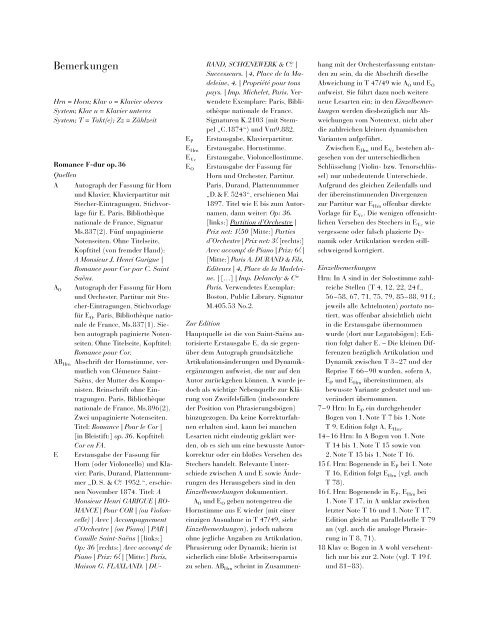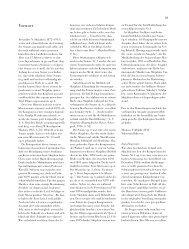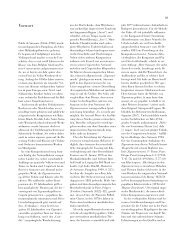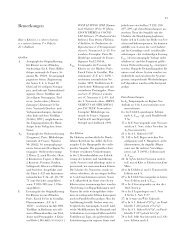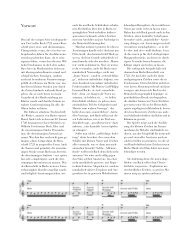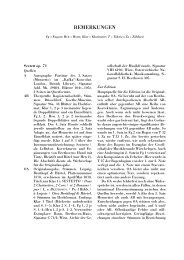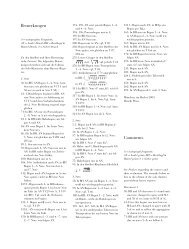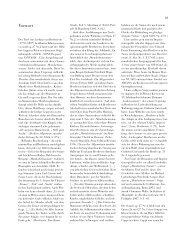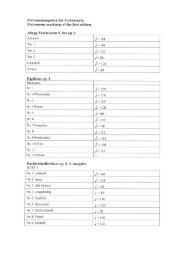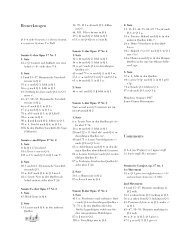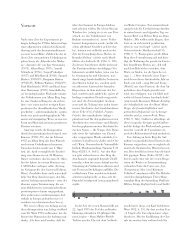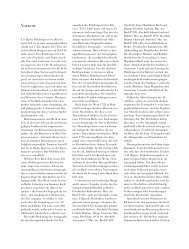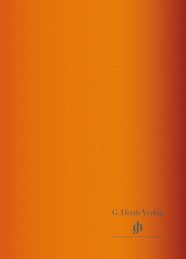Kritischer Bericht (PDF, 222 KB)
Kritischer Bericht (PDF, 222 KB)
Kritischer Bericht (PDF, 222 KB)
You also want an ePaper? Increase the reach of your titles
YUMPU automatically turns print PDFs into web optimized ePapers that Google loves.
12<br />
Bemerkungen<br />
Hrn = Horn; Klav o = Klavier oberes<br />
System; Klav u = Klavier unteres<br />
System; T = Takt(e); Zz = Zählzeit<br />
Romance F-dur op. 36<br />
Quellen<br />
A Autograph der Fassung für Horn<br />
und Klavier, Klavierpartitur mit<br />
Stecher-Eintragungen, Stichvorlage<br />
für E. Paris, Bibliothèque<br />
nationale de France, Signatur<br />
Ms.837(2). Fünf unpaginierte<br />
Notenseiten. Ohne Titelseite,<br />
Kopftitel (von fremder Hand):<br />
A Monsieur J. Henri Garigue |<br />
Romance pour Cor par C. Saint<br />
Saëns.<br />
A O Autograph der Fassung für Horn<br />
und Orchester, Partitur mit Stecher-Eintragungen,<br />
Stichvorlage<br />
für E O . Paris, Bibliothèque nationale<br />
de France, Ms.837(1). Sieben<br />
autograph paginierte Notenseiten.<br />
Ohne Titelseite, Kopftitel:<br />
Romance pour Cor.<br />
AB Hrn Abschrift der Hornstimme, vermutlich<br />
von Clémence Saint-<br />
Saëns, der Mutter des Komponisten.<br />
Reinschrift ohne Eintragungen.<br />
Paris, Bibliothèque<br />
nationale de France, Ms.896(2).<br />
Zwei unpaginierte Notenseiten.<br />
Titel: Romance | Pour le Cor |<br />
[in Bleistift:] op. 36. Kopftitel:<br />
Cor en FA.<br />
E Erstausgabe der Fassung für<br />
Horn (oder Violoncello) und Klavier.<br />
Paris, Durand, Plattennummer<br />
„D. S. & C iẹ 1952.“, erschienen<br />
November 1874. Titel: A<br />
Monsieur Henri GARIGUE | RO-<br />
MANCE | Pour COR | (ou Violoncelle)<br />
| Avec | Accompagnement<br />
d’Orchestre | (ou Piano) | PAR |<br />
Camille Saint-Saëns | [links:]<br />
Op: 36 [rechts:] Avec accomp ṭ de<br />
Piano | Prix: 6 f . | [Mitte:] Paris,<br />
Maison G. FLAXLAND. | DU-<br />
E P<br />
E Hrn<br />
E Vc<br />
E O<br />
C iẹ<br />
RAND, SCHŒNEWERK & |<br />
Successeurs. | 4, Place de la Madeleine,<br />
4. | Propriété pour tous<br />
pays. | Imp. Michelet, Paris. Verwendete<br />
Exemplare: Paris, Bibliothèque<br />
nationale de France,<br />
Signaturen K.2103 (mit Stempel<br />
„C.1874“) und Vm9.882.<br />
Erstausgabe, Klavierpartitur.<br />
Erstausgabe, Hornstimme.<br />
Erstausgabe, Violoncellostimme.<br />
Erstausgabe der Fassung für<br />
Horn und Orchester, Partitur.<br />
Paris, Durand, Plattennummer<br />
„D.& F. 5243“, erschienen Mai<br />
1897. Titel wie E bis zum Autornamen,<br />
dann weiter: Op: 36.<br />
[links:] Partition d’Orchestre |<br />
Prix net: 1. f 50 [Mitte:] Parties<br />
d’Orchestre | Prix net: 3 f .[rechts:]<br />
Avec accomp ṭ de Piano | Prix: 6 f . |<br />
[Mitte:] Paris A. DURAND & Fils,<br />
Editeurs | 4, Place de la Madeleine.<br />
| […] | Imp. Delanchy & C ie<br />
Paris. Verwendetes Exemplar:<br />
Boston, Public Library, Signatur<br />
M.405.53 No.2.<br />
Zur Edition<br />
Hauptquelle ist die von Saint-Saëns autorisierte<br />
Erstausgabe E, da sie gegenüber<br />
dem Autograph grundsätzliche<br />
Artikulationsänderungen und Dynamikergänzungen<br />
aufweist, die nur auf den<br />
Autor zurückgehen können. A wurde jedoch<br />
als wichtige Nebenquelle zur Klärung<br />
von Zweifelsfällen (insbesondere<br />
der Position von Phrasierungsbögen)<br />
hinzugezogen. Da keine Korrekturfahnen<br />
erhalten sind, kann bei manchen<br />
Lesarten nicht eindeutig geklärt werden,<br />
ob es sich um eine bewusste Autorkorrektur<br />
oder ein bloßes Versehen des<br />
Stechers handelt. Relevante Unterschiede<br />
zwischen A und E sowie Änderungen<br />
des Herausgebers sind in den<br />
Einzelbemerkungen dokumentiert.<br />
A O und E O geben notengetreu die<br />
Hornstimme aus E wieder (mit einer<br />
einzigen Ausnahme in T 47/49, siehe<br />
Einzelbemerkungen), jedoch nahezu<br />
ohne jegliche Angaben zu Artikulation,<br />
Phrasierung oder Dynamik; hierin ist<br />
sicherlich eine bloße Arbeitsersparnis<br />
zu sehen. AB Hrn scheint in Zusammenhang<br />
mit der Orchesterfassung entstanden<br />
zu sein, da die Abschrift dieselbe<br />
Abweichung in T 47/49 wie A O und E O<br />
aufweist. Sie führt dazu noch weitere<br />
neue Lesarten ein; in den Einzelbemerkungen<br />
werden diesbezüglich nur Abweichungen<br />
vom Notentext, nicht aber<br />
die zahlreichen kleinen dynamischen<br />
Varianten aufgeführt.<br />
Zwischen E Hrn und E Vc bestehen abgesehen<br />
von der unterschiedlichen<br />
Schlüsselung (Violin- bzw. Tenorschlüssel)<br />
nur unbedeutende Unterschiede.<br />
Aufgrund des gleichen Zeilenfalls und<br />
der übereinstimmenden Divergenzen<br />
zur Partitur war E Hrn offenbar direkte<br />
Vorlage für E Vc . Die wenigen offensichtlichen<br />
Versehen des Stechers in E Vc wie<br />
vergessene oder falsch plazierte Dynamik<br />
oder Artikulation werden stillschweigend<br />
korrigiert.<br />
Einzelbemerkungen<br />
Hrn: In A sind in der Solostimme zahlreiche<br />
Stellen (T 4, 12, 22, 24 f.,<br />
56–58, 67, 71, 75, 79, 85–88, 91 f.;<br />
jeweils alle Achtelnoten) portato notiert,<br />
was offenbar absichtlich nicht<br />
in die Erstausgabe übernommen<br />
wurde (dort nur Legatobögen); Edition<br />
folgt daher E. – Die kleinen Differenzen<br />
bezüglich Artikulation und<br />
Dynamik zwischen T 3–27 und der<br />
Reprise T 66–90 wurden, sofern A,<br />
E P und E Hrn übereinstimmen, als<br />
bewusste Variante gedeutet und unverändert<br />
übernommen.<br />
7–9 Hrn: In E P ein durchgehender<br />
Bogen von 1. Note T 7 bis 1. Note<br />
T 9, Edition folgt A, E Hrn .<br />
14–16 Hrn: In A Bogen von 1. Note<br />
T 14 bis 1. Note T 15 sowie von<br />
2. Note T 15 bis 1. Note T 16.<br />
15 f. Hrn: Bogenende in E P bei 1. Note<br />
T 16, Edition folgt E Hrn (vgl. auch<br />
T 78).<br />
16 f. Hrn: Bogenende in E P , E Hrn bei<br />
1. Note T 17, in A unklar zwischen<br />
letzter Note T 16 und 1. Note T 17.<br />
Edition gleicht an Parallelstelle T 79<br />
an (vgl. auch die analoge Phrasierung<br />
in T 8, 71).<br />
18 Klav o: Bogen in A wohl versehentlich<br />
nur bis zur 2. Note (vgl. T 19 f.<br />
und 81–83).
13<br />
21 Klav o: Bogen in E bis 1. Note T 22,<br />
Edition folgt A.<br />
Hrn: In AB Hrn Pausentakt.<br />
21 f. Hrn: In E Hrn Beginn a bereits ab<br />
1. Note, Edition folgt A, E P .<br />
23 Hrn: In E Hrn kein a , Edition folgt<br />
A, E P .<br />
26 Klav, Hrn: Angabe pp nicht in A.<br />
29: Tempoangabe in E bereits in T 28<br />
auf 3. Zz, offensichtlich nur aus<br />
Platzmangel (Zeilenwechsel). In A<br />
Position zwischen 3. Zz T 28 und<br />
1. Zz T 29, aber wohl zu Beginn T 29<br />
gemeint.<br />
Hrn: In E Hrn ohne p und a ; Edition<br />
folgt E P .<br />
30 f. Klav o: Bogenenden in A unklar,<br />
aber wohl jeweils bis zur letzten Note<br />
im Takt gemeint, in E uneinheitlich<br />
interpretiert (2. Bogen bis 1. Note<br />
T 32). Edition folgt A.<br />
Klav u: In A, E ohne Bögen, wir ergänzen<br />
analog zur Oberstimme sowie<br />
T 38 Klav u.<br />
31 Hrn: Angabe ouvert zu 2. Note nicht<br />
in E, Edition folgt A (vgl. Vorwort). –<br />
Bogenende in E erst bei 1. Note T 32,<br />
Edition folgt A (vgl. Bogenende T 38).<br />
32 Hrn: In E P z auf 3. Zz statt u<br />
zu letzter Note, offensichtlich Fehllesung<br />
von A; Edition folgt E Hrn (vgl.<br />
auch T 39).<br />
35 Klav o: Bogenbeginn in E bereits bei<br />
1. Note; in A unklar (zwischen 1. und<br />
2. Note), jedoch im Hinblick auf<br />
das Motiv in Hrn T 33 und 40 wahrscheinlich<br />
ab 2. Note gemeint.<br />
37 f. Klav o: In E durchgehender Bogen<br />
von 1. Note T 37 bis 3. Note T 38,<br />
offensichtlich Fehllesung von A.<br />
Klav u: In A und E Bogen nur in<br />
T 38, wir ergänzen analog dazu<br />
Bogen in T 37 (vgl. auch T 30 f.).<br />
41 Klav: a nicht in E, A; ergänzt gemäß<br />
A O , E O und in Analogie zu T 43.<br />
42 Hrn: In E P kein Staccatopunkt zu<br />
letzter Note, ergänzt nach A, E Hrn .<br />
44 Hrn: In E P keine Staccatopunkte zu<br />
beiden letzten Noten, ergänzt nach A,<br />
E Hrn . – In AB Hrn Rhythmus der beiden<br />
letzten Noten l sowie u zu<br />
vorletzter Note.<br />
45 Hrn: In E Hrn sf sicher irrtümlich bereits<br />
zu 1. Note (zudem z erst ab<br />
T 46 2. Zz), Edition folgt A, E P .<br />
45–47 Hrn: In E Hrn Legatobögen von<br />
1. bis 2. Note T 45 und von 2. Note<br />
T 45 bis 1. Note T 47; im Hinblick<br />
auf die inkorrekte Dynamik (siehe<br />
vorige Anmerkung) wohl fehlerhaft.<br />
Edition folgt A, E P .<br />
45–49 Klav: In A sämtliche Achtelnoten<br />
mit Punkten (somit portato zu<br />
spielen wie T 43). Edition folgt E,<br />
da zu vermuten ist, dass diese erhebliche<br />
Abweichung auf eine Korrektur<br />
Saint-Saëns’ zurückgeht; die Legato-<br />
Phrasierung der Streicherbegleitung<br />
in A O bestätigt dies.<br />
47 Hrn: In E ohne a , Edition folgt A<br />
(vgl. auch T 49).<br />
47, 49 Hrn: In E vermutlich versehentlich<br />
kein Atemzeichen nach 1. Note,<br />
Edition folgt A. – In A O , E O , AB Hrn<br />
k statt v h<br />
Klav u: In E kein Verlängerungspunkt<br />
zu h , ergänzt nach A.<br />
51 Klav o: In E irrtümlich Staccatopunkt<br />
zu v auf 3. Zz, Fehllesung<br />
von A (ist Fortführungsstrich zur<br />
Dynamikangabe cres), korrigiert<br />
nach A.<br />
56 Hrn: z nicht in E P , Edition folgt<br />
A und E Hrn .<br />
59 Hrn: In AB Hrn Pausentakt.<br />
64 Hrn: In AB Hrn v statt a<br />
65 Klav u: In E 1. Note irrtümlich mit<br />
Staccatopunkt, Fehllesung von A (ist<br />
Abkürzungspunkt der Angabe o),<br />
korrigiert nach A.<br />
70 Hrn: In AB Hrn Rhythmus 2.–3. Note<br />
b a<br />
77 f. Hrn: In A Bogen von 1. Note T 77<br />
bis 1. Note T 78.<br />
78, 80 Hrn: In E P z zu 2./3. Zz T 78,<br />
aber ohne a in T 80, d. h. analog<br />
zur Parallelstelle T 15, 17. Edition<br />
folgt A und E Hrn , da eine bewusste<br />
Abwandlung der Dynamik in der<br />
Reprise plausibler ist: Auch die Angaben<br />
f, dim. und p aus T 15–17<br />
werden in T 78–80 nicht wiederholt.<br />
81 Hrn: In A O , E O k statt h<br />
84 Hrn: In AB Hrn h v statt k<br />
86 f. Hrn: In E Hrn Bogenende bei 1. Note<br />
T 87, Edition folgt A und E P (vgl.<br />
auch T 23).<br />
91 Hrn: In E vermutlich versehentlich<br />
ohne p, Edition folgt A.<br />
Romance E-dur op. 67<br />
Quellen<br />
[A] Autograph der Fassung für<br />
Horn und Orchester, Partiturreinschrift<br />
mit wenigen Korrekturen<br />
und Stecher-Eintragungen.<br />
15 Seiten, auf letzter Seite signiert<br />
und datiert Février 1866.<br />
Derzeitiger Verbleib unbekannt,<br />
letzter Nachweis im Auktionskatalog<br />
J. A. Stargardt Nr. 602<br />
(Auktion 27./28. November<br />
1973, Marburg), S. 202 f.<br />
A Korr Autographes Korrekturblatt zur<br />
Fassung für Horn und Klavier,<br />
umfasst sechs Änderungen des<br />
Klavierparts (jeweils zwischen<br />
1 und 3 Takten Länge). Paris,<br />
Bibliothèque nationale de France,<br />
Signatur Ms. 20673 (Dépôt<br />
E. Bruneau).<br />
E Erstausgabe der Fassung für<br />
Horn (oder Violoncello) und Klavier.<br />
Paris, J. Hamelle, Plattennummer<br />
„J. 2023 H.“, erschienen<br />
1885. Titel: A M r Henri Chaussier.<br />
| Romance | en Mi h | pour<br />
Cor ou Violoncelle | avec accompagnement<br />
d’Orchestre ou de |<br />
Piano | par | C. SAINT-SAENS. |<br />
Op. 67. | Propriété pour tous<br />
pays. | PARIS, J. HAMELLE ÉDI-<br />
TEUR | ANCIENNE MAISON J. MAHO |<br />
22 Boulevard Malesherbes 22. |<br />
J. 2023. H. | [links:] Edition pour<br />
| Cor (en Mi) et Piano Pr. net<br />
2Fr. [rechts:] Edition pour | Violoncelle<br />
et Piano Pr. 6 Fr. | [Mitte:]<br />
Partition d’Orchestre, net<br />
[Preisangabe fehlt] | Parties séparées<br />
" " [Preisangabe fehlt] |<br />
(avec celles de Cor et de Violoncelle<br />
solo) | Inst. Lith. de C. G.<br />
Röder, Leipzig. Verwendete<br />
Exemplare: Paris, Bibliothèque<br />
nationale de France, Signatur<br />
K.2104 (Ausgabe für Horn und<br />
Klavier); Staatsbibliothek zu<br />
Berlin · Preußischer Kulturbesitz,<br />
Signatur 47691 (Ausgabe<br />
für Violoncello und Klavier, mit<br />
abweichenden Preisangaben).<br />
E P Erstausgabe, Klavierpartitur.<br />
E Hrn Erstausgabe, Hornstimme.<br />
Erstausgabe, Violoncellostimme.<br />
E Vc
14<br />
AG Vc<br />
A2 P<br />
A2 KA<br />
Ausgabe der ursprünglichen Fassung<br />
für Violoncello und Klavier<br />
(als 4. Satz der Suite op. 16).<br />
Paris, Maho, Plattennummern<br />
„J. 657. M.“ (Titelseite) bzw.<br />
„J. 659_4_ M.“ (Innenseiten),<br />
erschienen 1866. Titel: À MON-<br />
SIEUR POËNCET. | SUITE |<br />
POUR | VIOLONCELLE ET PIA-<br />
NO | PAR | C. SAINT-SAËNS. |<br />
[links:] Op. 16. [rechts:] Complet<br />
Pr.net 7 fr. | N.º 1.2. Prélude et<br />
Sérénade Pr.6.fr. | N.º 3. Scherzo<br />
Pr.6.fr. | N.º 4. Romance Pr.6.fr. |<br />
N.º 5. Final Pr.6.fr. | Propriété de<br />
l’éditeur pour tous pays. | PARIS,<br />
J. MAHO, EDITEUR | 25 rue<br />
du faubourg S ṭ Honoré 25. |<br />
J. 657. M. | Inst. Lith. de C. G.<br />
Röder à Leipsic. Verwendetes<br />
Exemplar: Paris, Bibliothèque<br />
nationale de France, Signatur<br />
Vmg.7604(4).<br />
Autograph, Neufassung der Suite<br />
op. 16 (gezählt als op. 16 bis ) für<br />
Violoncello und Orchester, Partitur.<br />
Darin 4. Satz: Romance.<br />
23 autograph paginierte Notenseiten.<br />
Titelseite: 4. Romance.<br />
Paris, Bibliothèque nationale de<br />
France, Signatur Ms. 20822.<br />
Autograph, Neufassung der Suite<br />
op. 16 (gezählt als op. 16 bis )<br />
für Violoncello und Orchester,<br />
Klavierauszug. Darin 4. Satz:<br />
Romance. 7 autograph paginierte<br />
Notenseiten. Kopftitel: 4 |<br />
Romance. Paris, Bibliothèque<br />
nationale de France, Signatur<br />
Ms. 20821.<br />
Zur Edition<br />
Hauptquelle ist die von Saint-Saëns<br />
autorisierte Erstausgabe, autographe<br />
Quellen zu Opus 67 standen nicht zur<br />
Verfügung, abgesehen von der Reproduktion<br />
der letzten Notenseite von [A]<br />
im Auktionskatalog Stargardt, S. 203.<br />
Dieser Abbildung zufolge weist [A]<br />
Stecher-Eintragungen auf, eine Druckausgabe<br />
der Partitur oder der Orchesterstimmen<br />
ist jedoch nicht bekannt,<br />
worauf auch die diesbezüglich fehlenden<br />
Preisangaben in E hindeuten.<br />
In der Erstausgabe ist die separate<br />
Hornstimme wesentlich detaillierter mit<br />
Phrasierungsangaben versehen als die<br />
Stimme in der Klavierpartitur, auch<br />
die zusätzliche instrumentenspezifische<br />
Angabe ouvert und die erleichternden<br />
Ossia-Takte in der Coda legen nahe,<br />
dass Saint-Saëns in der Stimme für den<br />
Solisten Ergänzungen vornahm, die<br />
nicht in der Partitur nachgetragen wurden.<br />
Unsere Edition gibt daher E Hrn gegenüber<br />
E P den Vorzug; abweichende<br />
Lesarten von E P sind in den Einzelbemerkungen<br />
angeführt.<br />
Die Parallelausgabe von E für Violoncello<br />
übernimmt unverändert die Partitur<br />
der Hornfassung (d. h. mit überlegtem<br />
Hornsystem), sodass für den Cellopart<br />
E Vc die einzige Quelle darstellt,<br />
die im übrigen deutliche textliche Abweichungen<br />
gegenüber E Hrn aufweist<br />
(vgl. insbesondere die Neufassung der<br />
T 53–56, 60–62, 67–70, 88–95 sowie<br />
die rhythmische Variante in T 15; zudem<br />
sind T 8–13 und 84 f. nach unten<br />
oktaviert).<br />
Zur Klärung von Zweifelsfällen wurde<br />
die ursprüngliche Cellofassung aus<br />
der Suite op. 16 dann hinzugezogen,<br />
wenn davon auszugehen war, dass<br />
Saint-Saëns keine bewusste Änderung<br />
beabsichtigte (z. B. Harmonik und<br />
Rhythmus im Klaviersatz). Saint-Saëns’<br />
spätere Orchesterbearbeitung der Suite<br />
op. 16 aus dem Jahr 1919 wurde nur in<br />
Einzelfragen berücksichtigt. Alle relevanten<br />
Unterschiede und Änderungen<br />
gegenüber der jeweiligen Hauptquelle<br />
sind in den Einzelbemerkungen dokumentiert.<br />
Einzelbemerkungen<br />
7 Klav o: Unterstimme, 2. Takthälfte,<br />
3. Note in E ohne Vorzeichen, d. h.<br />
ais 1 ; korrigiert zu a 1 nach AG Vc und<br />
A2 KA .<br />
8–11, 20 f., 63–66, 76–79 Hrn: In E P<br />
nur jeweils ein ganztaktiger Bogen.<br />
9 Hrn: Bogen a 1 –d 2 in E Hrn bis dis 2 , angeglichen<br />
an T 64 und 77.<br />
10 Klav o: Obere Note im vorletzten Akkord<br />
in E ohne Vorzeichen, d. h. d 1 ;<br />
korrigiert zu dis 1 nach AG Vc und<br />
A2 KA .<br />
13, 15 Klav o: Oberste Note im letzten<br />
Akkord in E ohne Vorzeichen, d. h.<br />
d 1 , korrigiert zu dis 1 nach AG Vc (vgl.<br />
auch Solostimme sowie Parallelstelle<br />
T 71, 73).<br />
16 f. Hrn: In E P T 16 ohne Phrasierung,<br />
in T 17 zwei Bögen von 1.–4. bzw.<br />
5.–6. Note.<br />
23, 25 Klav u: In E Notation der Bögen<br />
zwischen 3. und 4. Akkord uneinheitlich;<br />
in T 23 keine Bögen, in T 25<br />
nur Bögen fis–fis und ais–a. Der<br />
Vergleich mit den jeweils analogen<br />
Stellen in AG Vc , A2 KA und A2 P legt<br />
jedoch Bogensetzung zwischen allen<br />
Noten der Akkorde nahe.<br />
27 f. Hrn: In E P Bogenende und Ende<br />
des z jeweils erst bei 3. Note, in<br />
T 28 u zu 1. Note; vgl. aber T 33 f.<br />
und E Hrn .<br />
29 Hrn: In E P mfp statt mf, Bogen und<br />
z fehlen.<br />
30 Hrn: In E P kein Bogen zu 5.–7. Note,<br />
a zu 2.–5. Note, z zu 5.–7.<br />
Note.<br />
33 Klav o: Haltebogen a 1 –a 1 nicht in E,<br />
vgl. aber T 34.<br />
Hrn: In E Hrn f statt sf, vgl. aber T 34<br />
und E P , E Vc . – In E P Ende des z<br />
erst bei 3. Note.<br />
33 f. Klav: Position der z in E P uneinheitlich,<br />
angeglichen an AG Vc ,<br />
A2 KA und A2 P .<br />
35 Hrn: In E P ein durchgehender Bogen<br />
zu 1.–4. Note.<br />
38 Hrn: In E P ein durchgehender Bogen<br />
zu 1.–6. Note.<br />
40 Hrn: In E P Staccatopunkte zu 4. und<br />
5. Note.<br />
41 Hrn: In E Hrn kein Bogen zu 1.–2.<br />
Note, vgl. aber T 42 und E P .<br />
44, 46 Klav: In E irrtümlich immer gis,<br />
Edition ergänzt h (vgl. auch AG Vc ).<br />
47 Hrn: In E P ohne z .<br />
50, 52 Klav u: In E ohne sf, Edition<br />
folgt A Korr , da Dynamik wahrscheinlich<br />
vom Stecher bei der Korrekturausführung<br />
übersehen wurde.<br />
51 Hrn: In E P f statt sf sowie ohne Angabe<br />
ouvert.<br />
53 Hrn: In E P ohne u und a .<br />
72 Hrn: In E P Staccatopunkte zu<br />
1.–3. Note sowie kein Bogen zu<br />
4.–10. Note, vgl. aber T 14 und<br />
E Hrn .
15<br />
73 Hrn: Phrasierung der beiden Sextolen<br />
in E P und E Hrn uneinheitlich, Edition<br />
folgt E Hrn unter Angleichung der<br />
2. an die 1. Stelle (Bogenende und<br />
Staccatopunkt zur 22. Note statt wie<br />
in E Hrn zur 21. Note). – In E P u statt<br />
Staccatopunkt zur 14. Note.<br />
74 Hrn: In E P Bogenende bei 7. Note.<br />
76–79 Klav o: Aus E geht nicht eindeutig<br />
hervor, ob Bögen nur als Triolenklammern<br />
gemeint sind, jedoch<br />
spricht die Notation dieser Stelle in<br />
AG Vc (T 65 f.) und A2 P (T 60–63,<br />
Flötenstimme) für eine Lesart als<br />
Legatobogen.<br />
81 Hrn: In E Hrn cresc. erst zu 5. Zz., vgl.<br />
aber E P (Hrn und Klav) und E Vc .<br />
81, 83 Klav: Bögen ergänzt nach AG Vc ,<br />
A2 KA und A2 P (siehe Bemerkung zu<br />
T23, 25).<br />
89 Hrn: In E P Bogen zu 2.–3. Note.<br />
90–95 Hrn: Erleichterte Variante fehlt<br />
in E P , ergänzt nach E Hrn .<br />
München, Frühjahr 2012<br />
Dominik Rahmer<br />
Comments<br />
hn = horn; pf u = piano upper staff;<br />
pf l = piano lower staff; M = measure(s)<br />
Romance in F major op. 36<br />
Sources<br />
A Autograph of the version for<br />
horn and piano, piano score with<br />
engraver’s entries, engraver’s<br />
copy for F. Paris, Bibliothèque<br />
nationale de France, shelfmark<br />
Ms.837(2). Five pages of music<br />
without pagination. No title<br />
page, head title (by another<br />
hand): A Monsieur J. Henri Garigue<br />
| Romance pour Cor par<br />
C. Saint Saëns.<br />
A O Autograph of the version for<br />
horn and orchestra, score with<br />
engraver’s entries, engraver’s<br />
C hn<br />
F<br />
F S<br />
F hn<br />
F vc<br />
F O<br />
copy for F O . Paris, Bibliothèque<br />
nationale de France, Ms.837(1).<br />
Seven pages of music paginated<br />
by the composer. No title page,<br />
head title: Romance pour Cor.<br />
Copy of the horn part, presumably<br />
by Clémence Saint-Saëns,<br />
the composer’s mother. Fair<br />
copy without any added entries.<br />
Paris, Bibliothèque nationale de<br />
France, Ms.896(2). Two pages<br />
of music without pagination.<br />
Title: Romance | Pour le Cor |<br />
[in pencil:] op. 36. Head title:<br />
Cor en FA.<br />
First edition of the version for<br />
horn (or cello) and piano. Paris,<br />
Durand, plate number “D. S. &<br />
C iẹ 1952.”, published in November<br />
1874. Title: A Monsieur Henri<br />
GARIGUE | ROMANCE | Pour<br />
COR | (ou Violoncelle) | Avec |<br />
Accompagnement d’Orchestre |<br />
(ou Piano) | PAR | Camille Saint-<br />
Saëns | [left:] Op: 36 [right:]<br />
Avec accomp ṭ de Piano | Prix: 6 f . |<br />
[centre:] Paris, Maison G. FLAX-<br />
LAND. | DURAND, SCHŒNE-<br />
WERK & C iẹ | Successeurs. |<br />
4, Place de la Madeleine, 4. |<br />
Propriété pour tous pays. | Imp.<br />
Michelet, Paris. Copies consulted:<br />
Paris, Bibliothèque nationale<br />
de France, shelfmark<br />
K.2103 (stamped “C.1874”)<br />
and Vm9.882.<br />
First edition, piano score.<br />
First edition, horn part.<br />
First edition, violoncello part.<br />
First edition of the version for<br />
horn and orchestra, score. Paris,<br />
Durand, plate number “D.& F.<br />
5243”, published in May 1897.<br />
Title as in F up to the composer’s<br />
name, then: Op: 36. [left:] Partition<br />
d’Orchestre | Prix net: 1. f 50<br />
[centre:] Parties d’Orchestre |<br />
Prix net: 3 f .[right:] Avec accomp ṭ<br />
de Piano | Prix: 6 f . | [centre:]<br />
Paris A. DURAND & Fils, Editeurs<br />
| 4, Place de la Madeleine. |<br />
[…] | Imp. Delanchy & C ie Paris.<br />
Copy consulted: Boston, Public<br />
Library, shelfmark M.405.53<br />
No.2.<br />
About this edition<br />
The primary source is the first edition F<br />
as authorised by Saint-Saëns, since it<br />
offers substantial alterations to articulation<br />
markings and extra dynamics with<br />
respect to the autograph. These can only<br />
stem from the composer. However, A<br />
also served as an important secondary<br />
source for the clarification of ambiguous<br />
cases (especially the position of phrasing<br />
slurs). Since no galley proofs have<br />
survived, certain readings cannot be determined<br />
unequivocally; they might be a<br />
deliberate correction on the part of the<br />
composer, or a mere oversight of the engraver.<br />
Relevant discrepancies between<br />
A and F, as well as emendations made<br />
by the editor, are documented in the<br />
Individual comments.<br />
A O and F O faithfully reproduce the<br />
horn part from F, note-for-note (with<br />
one single exception at M 47/49, see Individual<br />
comments), but with practically<br />
no articulation, phrasing or dynamic<br />
markings whatsoever; these were surely<br />
omitted only as a labour-saving measure.<br />
C hn seems to have been written in<br />
conjunction with the orchestral version,<br />
since the copy contains the same divergence<br />
in M 47/49 as A O and F O , but also<br />
introduces further new readings. Only<br />
divergences from the musical text – not<br />
the many little dynamic variants – are<br />
listed in the Individual comments.<br />
Apart from the discrepant clefs (the<br />
use of the treble and tenor clefs respectively),<br />
there are only insignificant differences<br />
between F hn and F vc . Judging<br />
from the identical disposition of the<br />
lines and the concordant divergences<br />
with the score, F hn was apparently used<br />
as the direct source for F vc . The engraver’s<br />
few obvious oversights in F vc such as<br />
forgotten or erroneously placed dynamics<br />
or articulation markings are corrected<br />
without comment.<br />
Individual comments<br />
hn: In A many passages of the solo part<br />
are notated portato (M 4, 12, 22,<br />
24 f., 56–58, 67, 71, 75, 79, 85–88,<br />
91 f.; all eighth notes respectively);<br />
this was apparently intentionally left<br />
out of the first edition (there only<br />
legato slurs). Our edition thus follows
16<br />
F. – The minor differences with respect<br />
to articulation and dynamics<br />
between M 3–27 and the reprise at<br />
M 66–90 were included without<br />
change as deliberate variants, inasmuch<br />
as A, F S and F hn are all concurrent.<br />
7–9 hn: F S has one uninterrupted slur<br />
from 1 st note of M 7 to 1 st note of<br />
M 9; our edition follows A, F hn .<br />
14–16 hn: A has slur from 1 st note of<br />
M14 to 1 st note of M 15 as well as<br />
from 2 nd note of M 15 to 1 st note of<br />
M16.<br />
15 f. hn: End of slur in F S at 1 st note of<br />
M 16; our edition follows F hn (cf. also<br />
M78).<br />
16 f. hn: End of slur in F S , F hn at 1 st<br />
note of M 17; in A unclear between<br />
last note of M 16 and 1 st note of<br />
M 17. Our edition changes to match<br />
parallel passage at M 79 (also cf. the<br />
analogous phrasing in M 8, 71).<br />
18 pf u: Slur in A probably erroneously<br />
only to 2 nd note (cf. M 19 f. and 81–<br />
83).<br />
21 pf u: Slur in F to 1 st note of M 22;<br />
our edition follows A.<br />
hn: C hn has one measure rest.<br />
21 f. hn: In F hn a already begins at<br />
1 st note, our edition follows A, F S .<br />
23 hn: In F hn no a ; our edition follows<br />
A, F S .<br />
26 pf, hn: A lacks pp marking.<br />
29: F has tempo marking already on<br />
3 rd beat of M 28, apparently only for<br />
reasons of space (change of line). In<br />
A placed between 3 rd beat of M 28<br />
and 1 st beat of M 29, but probably<br />
intended at beginning of M 29.<br />
hn: F hn lacks p and a ; our edition<br />
follows F S .<br />
30 f. pf u: Ends of slurs unclear in A,<br />
but probably intended to extend to<br />
last note in measure; in F interpreted<br />
irregularly (2 nd slur to 1 st note of<br />
M 32). Our edition follows A.<br />
pf l: A, F lack slurs; we supplement<br />
analogously to the upper part as well<br />
as M 38 pf l.<br />
31 hn: Indication ouvert at 2 nd note not<br />
in F; our edition follows A (cf. Preface).<br />
– End of slur in F not until<br />
1 st note of M 32; our edition follows<br />
A (cf. also end of slur at M 38).<br />
32 hn: F S has z on 3 rd beat instead<br />
of u on last note, obvious misreading<br />
of A; our edition follows F hn (cf. also<br />
M 39).<br />
35 pf u: Slur in F already begins at 1 st<br />
note; unclear in A (between 1 st and<br />
2 nd note), but presumably intended<br />
from 2 nd note in view of the motif in<br />
hn M 33 and 40.<br />
37 f. pf u: F has one uninterrupted slur<br />
from 1 st note of M 37 to 3 rd note of<br />
M 38, obvious misreading of A.<br />
pf l: A and F have slur only in M 38;<br />
we add a matching slur in M 37 (cf.<br />
also M 30 f.).<br />
41 pf: F and A lack a ; added to<br />
match A O , F O and in analogy to<br />
M 43.<br />
42 hn: F S lacks staccato dot at last note;<br />
added to match A, F hn .<br />
44 hn: F S lacks staccato dots at last two<br />
notes; added to match A, F hn . – In C hn<br />
rhythm of the last two notes l as<br />
well as u at penultimate note.<br />
45 hn: F hn has sf already at 1 st note, no<br />
doubt by error (moreover z not<br />
until 2 nd beat of M 46); our edition<br />
follows A, F S .<br />
45–47 hn: In F hn 1 st –2 nd notes of M 45<br />
slurred, and slur from 2 nd note of<br />
M 45 to 1 st note of M 47; probably by<br />
error in view of the incorrect dynamics<br />
(see preceding note). Our edition<br />
follows A, F S .<br />
45–49 pf: In A all eighth notes with<br />
dots (thus to be played portato as in<br />
M 43). Our edition follows F, since it<br />
is likely that this substantial divergence<br />
is based on a correction by<br />
Saint-Saëns; the legato phrasing of<br />
the string accompaniment in A O confirms<br />
this.<br />
47 hn: F lacks a , our edition follows<br />
A (cf. also M 49).<br />
47, 49 hn: F lacks breathing mark after<br />
1 st note, probably by error; our edition<br />
follows A. – In A O , F O , C hn k<br />
instead of v h<br />
pf l: F lacks augmentation dot at h ,<br />
added to match A.<br />
51 pf u: F has staccato dot by mistake<br />
on v at the 3 rd beat; misreading of A<br />
(continuation dash at dynamic marking<br />
cres), corrected as in A.<br />
56 hn: F S lacks z ; our edition follows<br />
A and F hn .<br />
59 hn: C hn has one measure rest.<br />
64 hn: C hn has v instead of a<br />
65 pf l: In F 1 st note erroneously with<br />
staccato dot, misreading of A (abbreviation<br />
dot of the marking o),<br />
corrected as in A.<br />
70 hn: In C hn rhythm of 2 nd –3 rd notes<br />
ba<br />
77 f. hn: A has slur from 1 st note of<br />
M 77 to 1 st note of M 78.<br />
78, 80 hn: F S has z at 2 nd /3 rd beats<br />
of M 78, but without a in M 80,<br />
i. e. analogously to the parallel passage<br />
at M 15, 17. Our edition follows<br />
A and F hn , since a deliberate alteration<br />
of the dynamics in the reprise<br />
is more plausible: the indications f,<br />
dim. and p from M 15–17 are also<br />
not repeated in M 78–80.<br />
81 hn: A O , F O have k instead of h<br />
84 hn: C hn has h v instead of k<br />
86 f. hn: In F hn end of slur at 1 st note of<br />
M 87; our edition follows A and F S<br />
(cf. also M 23).<br />
91 hn: F lacks p, presumably erroneously;<br />
our edition follows A.<br />
Romance in E major op. 67<br />
Sources<br />
[A] Autograph of the version for<br />
horn and orchestra, fair copy of<br />
score with few corrections and<br />
engraver’s entries. 15 pages,<br />
signed and dated Février 1866<br />
on last page. Current location<br />
unknown, last ascertained location<br />
in auction catalogue of J. A.<br />
Stargardt no. 602 (auction of 27/<br />
28 November 1973, Marburg),<br />
pp. 202 f.<br />
A Corr Autograph leaf with corrections<br />
for the version for horn and piano,<br />
comprising six alterations<br />
of the piano part (each between<br />
1 and 3 measures long). Paris,<br />
Bibliothèque nationale de<br />
France, shelfmark Ms. 20673<br />
(Dépôt E. Bruneau).<br />
F First edition of the version for<br />
horn (or cello) and piano. Paris,<br />
J. Hamelle, plate number<br />
“J. 2023 H.”, published in 1885.<br />
Title: A M r Henri Chaussier. | Romance<br />
| en Mi h | pour Cor ou Vio-
17<br />
F S<br />
F hn<br />
F vc<br />
ED vc<br />
A2 S<br />
loncelle | avec accompagnement<br />
d’Orchestre ou de | Piano | par |<br />
C. SAINT-SAENS. | Op. 67. | Propriété<br />
pour tous pays. | PARIS,<br />
J. HAMELLE ÉDITEUR | ANCIENNE<br />
MAISON J. MAHO | 22 Boulevard<br />
Malesherbes 22. | J. 2023. H. |<br />
[left:] Edition pour | Cor (en Mi)<br />
et Piano Pr. net 2 Fr. [right:]<br />
Edition pour | Violoncelle et Piano<br />
Pr. 6 Fr. | [centre:] Partition<br />
d’Orchestre, net [price indication<br />
missing] | Parties séparées " "<br />
[price indication missing] | (avec<br />
celles de Cor et de Violoncelle<br />
solo) | Inst. Lith. de C. G. Röder,<br />
Leipzig. Copies consulted: Paris,<br />
Bibliothèque nationale de France,<br />
shelfmark K.2104 (edition<br />
for horn and piano); Staatsbibliothek<br />
zu Berlin · Preußischer<br />
Kulturbesitz, shelfmark 47691<br />
(edition for violoncello and piano,<br />
with divergent price indications).<br />
First edition, piano score.<br />
First edition, horn part.<br />
First edition, violoncello part.<br />
Edition of the original version<br />
for violoncello and piano (as 4 th<br />
movement of the Suite op. 16).<br />
Paris, Maho, plate numbers<br />
“J. 657. M.” (title page) and<br />
“J. 659_4_ M.” (inner pages),<br />
published in 1866. Title: À<br />
MONSIEUR POËNCET. | SUITE |<br />
POUR | VIOLONCELLE ET PI-<br />
ANO | PAR | C. SAINT-SAËNS. |<br />
[left:] Op. 16. [right:] Complet<br />
Pr.net 7 fr. | N.º 1.2. Prélude et<br />
Sérénade Pr.6.fr. | N.º 3. Scherzo<br />
Pr.6.fr. | N.º 4. Romance Pr.6.fr. |<br />
N.º 5. Final Pr.6.fr. | Propriété de<br />
l’éditeur pour tous pays. | PARIS,<br />
J. MAHO, EDITEUR | 25 rue du<br />
faubourg S ṭ Honoré 25. | J. 657.<br />
M. | Inst. Lith. de C. G. Röder à<br />
Leipsic. Copy consulted: Paris,<br />
Bibliothèque nationale de France,<br />
shelfmark Vmg.7604(4).<br />
Autograph of the new version of<br />
the Suite op. 16 (numbered as<br />
op. 16 bis ) for violoncello and orchestra,<br />
score. Herein 4 th movement:<br />
Romance. 23 pages of<br />
A2 PR<br />
music paginated by the composer.<br />
Title page: 4. Romance.<br />
Paris, Bibliothèque nationale de<br />
France, shelfmark Ms. 20822.<br />
Autograph of the new version of<br />
the Suite op. 16 (numbered as<br />
op. 16 bis ) for violoncello and orchestra,<br />
piano reduction. Herein<br />
4 th movement: Romance. 7 pages<br />
of music paginated by the composer.<br />
Head title: 4 | Romance.<br />
Paris, Bibliothèque nationale de<br />
France, shelfmark Ms. 20821.<br />
About this edition<br />
The primary source is the first edition<br />
authorised by Saint-Saëns; autograph<br />
sources for op. 67 were not available,<br />
apart from the reproduction of the last<br />
page of music of [A] in the Stargardt<br />
auction catalogue, p. 203. According to<br />
this reproduction, [A] bears engraver’s<br />
entries, even if there is no known printed<br />
edition of the score or the orchestral<br />
parts; this is also suggested by the omission<br />
of the relevant price indications<br />
in F.<br />
In the first edition, the separate horn<br />
part is supplied with phrasings that are<br />
much more detailed than those in the<br />
part of the piano score, and the additional<br />
indication ouvert, specific to the<br />
horn, along with the simplified ossia<br />
measures in the coda also suggest that<br />
Saint-Saëns made emendations in the<br />
soloist’s part which were not subsequently<br />
entered into the score. Our edition<br />
thus gives priority to F hn over F S ;<br />
divergent readings of F S are listed in the<br />
Individual comments.<br />
The parallel violoncello edition of F<br />
offers the score of the horn version without<br />
change (i. e. with horn staff added<br />
above), so that F vc is the sole source for<br />
the cello part. This, moreover, bears<br />
clear textual divergences with respect to<br />
F hn (cf. in particular the new versions of<br />
M 53–56, 60–62, 67–70, 88–95 as<br />
well as the rhythmic variant in M 15;<br />
moreover, M 8–13 and 84 f. are notated<br />
one octave lower).<br />
For the clarification of ambiguous<br />
cases, the original cello version of the<br />
Suite op. 16 was taken into account<br />
wherever it could be assumed that<br />
Saint-Saëns did not intend any deliberate<br />
alterations (e. g. in harmony and<br />
rhythm in the piano part). Consideration<br />
was given to Saint-Saëns’ later orchestral<br />
arrangement of the Suite op. 16<br />
from 1919 only in specific matters. All<br />
relevant differences and changes with<br />
respect to the primary source are documented<br />
in the Individual comments.<br />
Individual comments<br />
7 pf u: Lower part, 2 nd half of measure,<br />
3 rd note in F without accidental, i. e.<br />
ak 1 ; corrected to a 1 as in ED vc and<br />
A2 PR .<br />
8–11, 20 f., 63–66, 76–79 hn: F S has<br />
only one whole-measure slur each<br />
time.<br />
9 hn: Slur a 1 –d 2 in F hn to d k 2 , changed<br />
to match M 64 and 77.<br />
10 pf u: Upper note in penultimate<br />
chord in F without accidental, i. e.<br />
d 1 ; corrected to d k 1 as in ED vc and<br />
A2 PR .<br />
13, 15 pf u: Uppermost note in last<br />
chord in F without accidental, i. e.<br />
d 1 , corrected to d k 1 as in ED vc (cf.<br />
also solo part as well as parallel<br />
passage at M 71, 73).<br />
16 f. hn: F S M 16 lacks phrasing, in<br />
M 17 two slurs from 1 st –4 th and<br />
5 th –6 th notes.<br />
23, 25 pf l: F has irregular notation of<br />
the slurs between 3 rd and 4 th chords;<br />
in M 23 no slurs, in M 25 only slurs<br />
from f k–f k and ak–a. However, a<br />
comparison with the analogous passages<br />
in ED vc , A2 PR and A2 S suggests<br />
a slurring between all notes of the<br />
chords.<br />
27 f. hn: In F S end of slurring and end<br />
of z not until the 3 rd note each<br />
time, in M 28 u at 1 st note; but cf.<br />
M33f. and F hn .<br />
29 hn: F S has mfp instead of mf, slur<br />
and z missing.<br />
30 hn: F S lacks slur at 5 th –7 th notes,<br />
a at 2 nd –5 th notes, z at 5 th –7 th<br />
notes.<br />
33 pf u: Tie at a 1 –a 1 not in F, but cf.<br />
M 34.<br />
hn: F hn has f instead of sf, but cf.<br />
M 34 and F S , F vc . – In F S end of the<br />
z not until 3 rd note.
18<br />
33 f. pf: Position of z inconsistent in<br />
F S , changed to match ED vc , A2 PR and<br />
A2 S .<br />
35 hn: F S has one uninterrupted slur<br />
from 1 st –4 th notes.<br />
38 hn: F S has one uninterrupted slur<br />
from 1 st –6 th notes.<br />
40 hn: F S has staccato dots at 4 th and<br />
5 th notes.<br />
41 hn: F hn lacks slur at 1 st –2 nd notes,<br />
but cf. M 42 and F S .<br />
44, 46 pf: F always has g k , erroneously;<br />
our edition adds h (cf. also ED vc ).<br />
47 hn: F S lacks z .<br />
50, 52 pf l: F lacks sf; our edition follows<br />
A Corr , since dynamics probably<br />
overlooked by engraver during correction<br />
process.<br />
51 hn: F S has f instead of sf and without<br />
indication ouvert.<br />
53 hn: F S lacks u and a .<br />
72 hn: F S has staccato dots at 1 st –3 rd<br />
notes and no slur at 4 th –10 th notes,<br />
but cf. also M 14 and F hn .<br />
73 hn: Irregular phrasing of the two<br />
sextuplets in F S and F hn ; our edition<br />
follows F hn with adjustment of the<br />
2 nd passage to the 1 st (end of slur and<br />
staccato dot at 22 nd note instead of<br />
21 st note as in F hn ). – F S has u instead<br />
of staccato dot at 14 th note.<br />
74 hn: F S has end of slur at 7 th note.<br />
76–79 pf u: From F it does not emerge<br />
unequivocally whether the slurs are<br />
intended only as triplet brackets;<br />
however, the notation of this passage<br />
in ED vc (M 65 f.) and A2 S (M 60–63,<br />
flute part) speaks for a reading as<br />
legato slur.<br />
81 hn: F hn has cresc. not until 5 th beat,<br />
but cf. F S (hn and pf) and F vc .<br />
81, 83 pf: Slurs added to match ED vc ,<br />
A2 PR and A2 S (see comment on M 23,<br />
25).<br />
89 hn: In F S 2 nd –3 rd notes slurred.<br />
90–95 hn: F S lacks simplified variant,<br />
added to match F hn .<br />
Munich, spring 2012<br />
Dominik Rahmer


